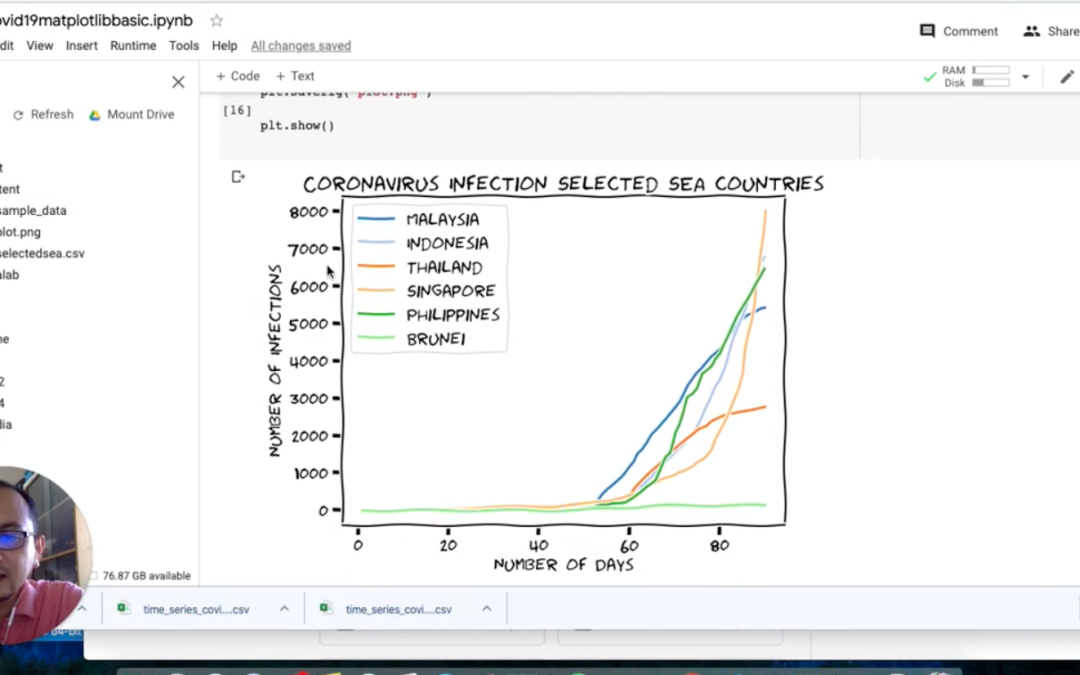The introduction of the MCO has led to the stop of all face to face lectures. Although online learning has been around for sometimes, It has never been in such limelight and needs as of today.
Teachers and lecturers are no more assisted by the well-equipped labs, whiteboard and markers, and the (now luxury) face to face interactions. Students with varying backgrounds have to go back home, away from the conducive environment of the campus. They no longer have easy access to labs to do the substantial works, professors to refer to, libraries for research and discussions, sports centres, high-speed internet access, and friends to discuss with and socialising.
In teaching data visualisation programming, I have decided to use Python as the programming language (instead of C++), Google Collaboratory as the programming platform, COVID dataset, YouTube video as the lecturing platform, and UTM’s Moodle-based e-learning portal to organise and disseminate the lectures. Why?
Python as the programming language: Currently, Python is the most robust language available for data analytics. Most of the industry players and researches in analytics are either using R or Python in their frameworks. I have chosen Python over R, due to the programming flexibility, where Python is a deployment-focused language, while R is analytics-focused language.
Google Collaboratory as the programming platform: The free to use Google collaboratory allow the users to program Python straight away with zero configuration. It is also supported with enough cloud computing power for any average teaching and learning programming activities. Google Collaboratory is the solution as most of the students are now relying on their PCs at home, where some of their PCs are pretty outdated with slow CPUs and GPUs. Collaboratory also allows the users to annotate in the Jupyter notebook-style annotations, which make it easier for the students to code and annotate-on. Thank you, Google.
COVID dataset: Without face-to-face interactions, it is not easy to get students’ attention and interest to explore the concepts that you trying to introduce. COVID dataset allows the lectures to be in line with the current interest of everyone. There is a large online research community and resources dedicated to analysing the COVID datasets. This community and resources allow those who are interested in exploring to get involved and learn more. The dataset used in my lecture was obtained from the official United Nation OCHA Humanitarian Data Exchange page.
YouTube video as lecturing platform: Asynchronous learning and Internet speed are the keywords here. Malaysia internet speed landscape varies from one location to another. Some have better internet, while some still stuck with kbps speeds. In levelling the access challenges, YouTube allows users to view their videos with the right quality for the right speed. Most of the Malaysian internet providers are also giving free unlimited/large bandwidth access to streaming services, which students can use them for the benefit of their learning. While to record the video, I used Loom, which allows me to record my lecture (lecture slides + audio + pc camera), that gave a little bit feel of face-to-face interactions for the students.
Conclusion: There is no instant silver bullet or one-solution-for-all in moving from face-to-face lectures to online learning during the MCO (lockdown) and post-COVID teaching and learning. My recipe (solution) emphasises on the technologies that are available and accessible to everyone. This is just one of many solutions out there. Here is my first online lecture on YouTube posted on 21st April 2020:


